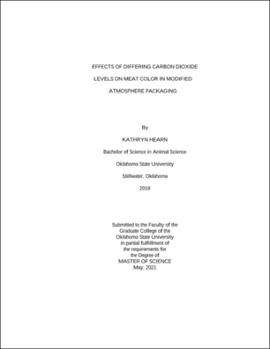| dc.contributor.advisor | Mafi, Gretchen | |
| dc.contributor.author | Hearn, Kathryn | |
| dc.date.accessioned | 2021-09-24T13:58:02Z | |
| dc.date.available | 2021-09-24T13:58:02Z | |
| dc.date.issued | 2021-05 | |
| dc.identifier.uri | https://hdl.handle.net/11244/330920 | |
| dc.description.abstract | The objective of this study was to assess the effect of different carbon dioxide (CO2) concentration gas flushes in master packages on the display life of fresh beef. Twenty-five USDA Low Choice ribeye rolls (IMPS 112A) from carcasses in program G-87B (USDA-AMS; live specification - Angus) were collected from Creekstone Farms in Arkansas City, KS. Each sub-primal was wet aged for 12 d. After aging, each sub-primal was opened and over sprayed with a SYNTRx 3300 solution. Ribeye rolls were sliced 2.54 cm thick and placed onto foam trays (n = 108 trays) with an absorbent pad and over-wrapped with perforated polyolefin film. Trays were randomly assigned to either a 10%, 20% or 30% CO2 concentration master bag (n = 27 master bags; n = 9/CO2 concentration). Three master bags, containing four trays, for each CO2 concentration (10%, 20% and 30%) were randomly selected for opening after 10, 15, 18 d of dark storage, and the trays were placed in a display case for retail display evaluation for 5 d. Headspace analysis was conducted before each master bags were opened, and objective color measurements were collected on d 0 - 5 of retail display. Muscle color, surface discoloration and overall acceptability were analyzed daily by a trained panel (n = 6). The results of this study showed steaks from the 10% CO2 concentration darkened and discolored more (P < 0.05) rapidly than steaks from either the 20 or 30% CO2 concentrations. Additionally, steaks from master bags flushed with the 10% CO2 concentration were the only steaks in display to reach unacceptable levels and discrimination by consumers. Steaks from master bags flushed with 20 or 30% CO2 concentration performed comparably (P > 0.05) with minimal differences. The 20% CO2 concentration master bag flush outperformed the 10% CO2 concentration in all aspects of the study, as well as surpassed or equaled the 30% CO2 concentration. Thus, it is recommended 20% CO2 concentration gas flush of master bags could be utilized by the industry to reduce CO2 use. | |
| dc.format | application/pdf | |
| dc.language | en_US | |
| dc.rights | Copyright is held by the author who has granted the Oklahoma State University Library the non-exclusive right to share this material in its institutional repository. Contact Digital Library Services at lib-dls@okstate.edu or 405-744-9161 for the permission policy on the use, reproduction or distribution of this material. | |
| dc.title | Effects of differing carbon dioxide levels on meat color in modified atmosphere packaging | |
| dc.contributor.committeeMember | Ramanathan, Ranjith | |
| dc.contributor.committeeMember | Wilson, Blake | |
| dc.contributor.committeeMember | Pfeiffer, Morgan | |
| osu.filename | Hearn_okstate_0664M_17156.pdf | |
| osu.accesstype | Open Access | |
| dc.type.genre | Thesis | |
| dc.type.material | Text | |
| dc.subject.keywords | carbon dioxide | |
| dc.subject.keywords | color | |
| dc.subject.keywords | modified atmosphere packaging | |
| thesis.degree.discipline | Animal Science | |
| thesis.degree.grantor | Oklahoma State University | |
